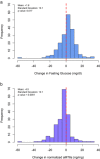Melatonin Pathway and Atenolol-Related Glucose Dysregulation: Is There a Correlation?
- PMID: 26946962
- PMCID: PMC4915567
- DOI: 10.1111/cts.12389
Melatonin Pathway and Atenolol-Related Glucose Dysregulation: Is There a Correlation?
Abstract
Lower melatonin level, melatonin receptor gene variations, and atenolol treatment are associated with glucose dysregulation. We investigated whether atenolol-related glucose and melatonin changes are correlated, and whether single nucleotide polymorphisms (SNPs) in melatonin candidate genes contribute to interindividual variation in glucose change. Hypertensive Caucasians (n = 232) from the Pharmacogenomic Evaluation of Antihypertensive Responses (PEAR) study treated with atenolol for 9 weeks were studied. Urinary 6-sulfatoxymelatonin (aMT6s) was measured pre- and posttreatment and normalized to urinary creatinine. Pharmacogenetic effects on glucose change of 160 SNPs in 16 melatonin candidate genes were assessed with multiple linear regression. Atenolol was associated with increased glucose (1.8 ± 10.1mg/dl, P = 0.02) and decreased aMT6s (-4.5 ± 10.1 ng/mg, P < 0.0001). However, the aMT6s change was not correlated with post-atenolol glucose change. SNP rs11649514 in PRKCB was associated with glucose change (P = 1.0×10(-4)). PRKCB is involved in the melatonin-insulin regulatory pathway, and may be important in mediating clinically meaningful atenolol-related hyperglycemia.
© 2016 The Authors. Clinical and Translational Science published by Wiley Periodicals, Inc. on behalf of American Society for Clinical Pharmacology and Therapeutics.
Figures




Similar articles
-
PROX1 gene variant is associated with fasting glucose change after antihypertensive treatment.Pharmacotherapy. 2014 Feb;34(2):123-30. doi: 10.1002/phar.1355. Epub 2013 Oct 9. Pharmacotherapy. 2014. PMID: 24122840 Free PMC article. Clinical Trial.
-
Influence of beta-blockers on melatonin release.Eur J Clin Pharmacol. 1999 Apr;55(2):111-5. doi: 10.1007/s002280050604. Eur J Clin Pharmacol. 1999. PMID: 10335905 Clinical Trial.
-
Melatonin response to atenolol administration in depression: indication of beta-adrenoceptor dysfunction in a subtype of depression.Acta Psychiatr Scand. 2002 Dec;106(6):440-5. doi: 10.1034/j.1600-0447.2002.02342.x. Acta Psychiatr Scand. 2002. PMID: 12392487
-
Atenolol induced HDL-C change in the pharmacogenomic evaluation of antihypertensive responses (PEAR) study.PLoS One. 2013 Oct 7;8(10):e76984. doi: 10.1371/journal.pone.0076984. eCollection 2013. PLoS One. 2013. PMID: 24116192 Free PMC article.
-
Reference intervals for 6-sulfatoxymelatonin in urine: A meta-analysis.Sleep Med Rev. 2022 Jun;63:101614. doi: 10.1016/j.smrv.2022.101614. Epub 2022 Mar 3. Sleep Med Rev. 2022. PMID: 35303691 Review.
Cited by
-
Antihypertensives associated adverse events: a review of mechanisms and pharmacogenomic biomarkers available evidence in multi-ethnic populations.Front Pharmacol. 2023 Dec 1;14:1286494. doi: 10.3389/fphar.2023.1286494. eCollection 2023. Front Pharmacol. 2023. PMID: 38108069 Free PMC article. Review.
-
Beneficial Effects of Melatonin on the In Vitro Maturation of Sheep Oocytes and Its Relation to Melatonin Receptors.Int J Mol Sci. 2017 Apr 17;18(4):834. doi: 10.3390/ijms18040834. Int J Mol Sci. 2017. PMID: 28420163 Free PMC article.
-
Melatonin improved glucose homeostasis is associated with the reprogrammed gut microbiota and reduced fecal levels of short-chain fatty acids in db/db mice.Food Sci Nutr. 2023 Jan 31;11(4):2012-2026. doi: 10.1002/fsn3.3237. eCollection 2023 Apr. Food Sci Nutr. 2023. PMID: 37051358 Free PMC article.
-
Melatonin Improves the Fertilization Capacity of Sex-Sorted Bull Sperm by Inhibiting Apoptosis and Increasing Fertilization Capacitation via MT1.Int J Mol Sci. 2019 Aug 12;20(16):3921. doi: 10.3390/ijms20163921. Int J Mol Sci. 2019. PMID: 31409031 Free PMC article.
References
Publication types
MeSH terms
Substances
Grants and funding
LinkOut - more resources
Full Text Sources
Other Literature Sources
Molecular Biology Databases
Miscellaneous

